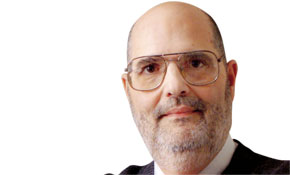
Wide-format printing used to refer to any device that prints on signage 24 inches or wider. However, new high-speed inkjet systems for documents are printing 24.5 and 30 inches wide, so the definition may have to be expanded to 36 inches or more. These devices print signs, posters, displays, banners and many other products.
Inkjet printing is divided into continuous inkjet – a stream of ink or drop-on-demand (DOD) – a drop as needed. DOD can be thermal (heat creates drop) or piezo (pressure creates drop). Inkjet inks can be water-based (also called aqueous), oil-based, solvent-based, eco-solvent-based, UV-based, hybrid, or other. Printers can be sheetfed, roll fed (also called web-fed or continuous feed), flatbed (can handle thick materials), or both roll and sheet (hybrid). Substrates may be coated, uncoated, paper, plastic, or fabric.
Single-pass printing
Wide-format printers cannot achieve the speeds required for high-volume production if they remain with scanning (shuttle) print head modules. Stitched print heads are being assembled in wider configurations. They are expensive and increase prices. As single-pass printers are introduced, they will move the wide-format printer into new configurations. Wide format will become narrow format to compete with small-format printing presses and flatbeds will metamorphose into larger-format sheetfed printers.
Wraps
Buildings and structures in the world are being transformed by colourful photo-quality signage. There are definitional differences between signage that just hangs and signage that wraps. Wraps must encompass at least two sides of the structure or vehicle; although some say that if the signage is simply affixed (adheres) to the structure or vehicle, it is a wrap. In any case, signage that is used on buildings and vehicles is a very large and growing market
Ink developments
The definitions of aqueous, solvent, UV, and other inkjet inks are changing as ink companies discover new combinations of chemistries. Although UV will be a growth area, no one ink type will dominate. Each will find a niche market. The most important developments will come in a new family of hybrid inks that will offer the benefits of eco-solvent inks while providing superior performance.
New commercial users
The signage market was within the scope of the sign printer, who used hand painting, vinyl cutting, screen printing, and other methods to produce banners and displays. Commercial printers have been involved through the printing of offset litho sheets, which were then mounted on heavy substrates and diecut. Screen printers used screen printing for a host of signage, textile, and industrial applications. Copy shops used copying machines and now multi-function printers.
Grayscale inkjet will dominate
Binary printing is enabled by DOD print heads that either fire a droplet of one particular size or droplets of different sizes. Grayscale print heads fire droplets made up of smaller sub droplets of varying droplet sizes. The result of variable-dot printing is photographic image quality. The trend is away from binary inkjet printing toward grayscale/variable drop size print heads.
Frank Romano is professor emeritus at the Rochester Institute of Technology
Comment below to have your say on this story.
If you have a news story or tip-off, get in touch at editorial@sprinter.com.au.
Sign up to the Sprinter newsletter
